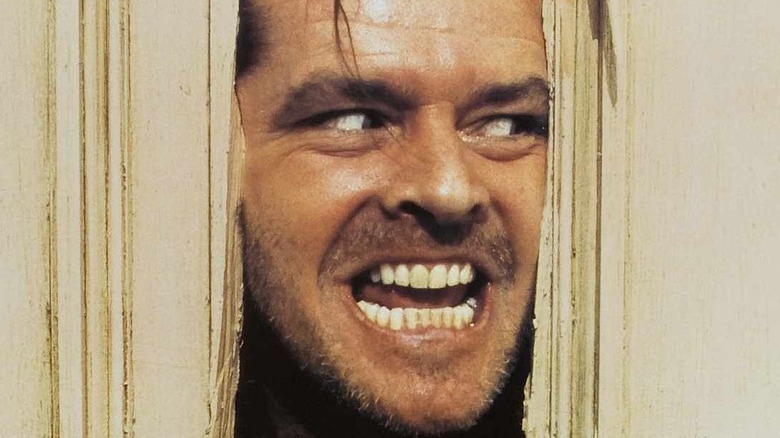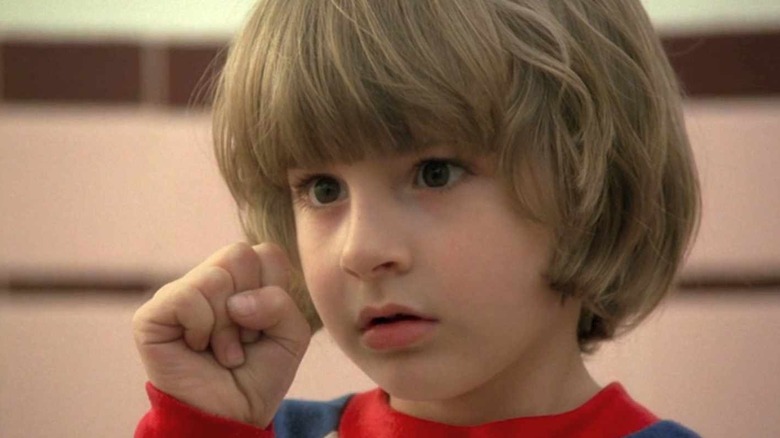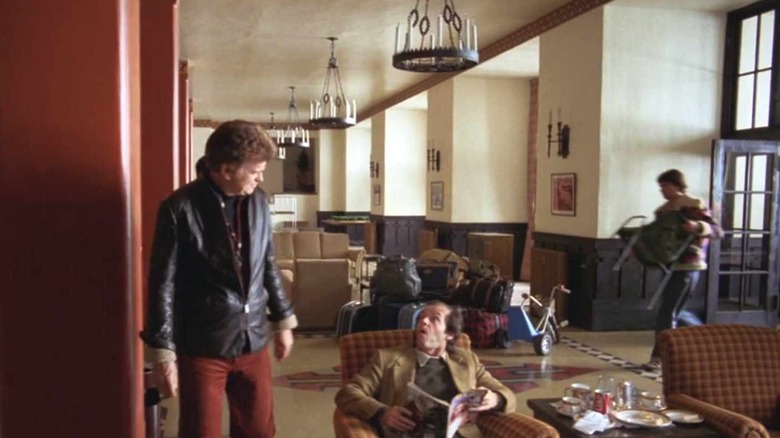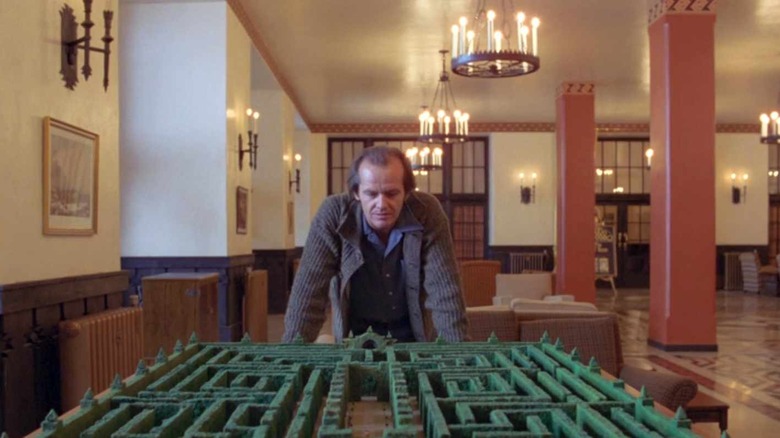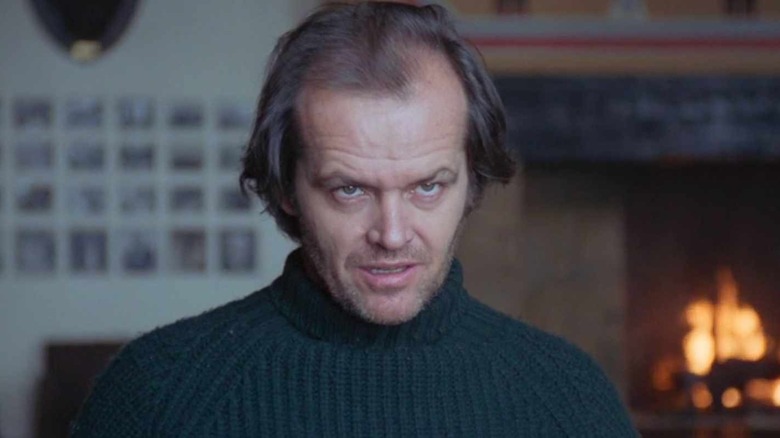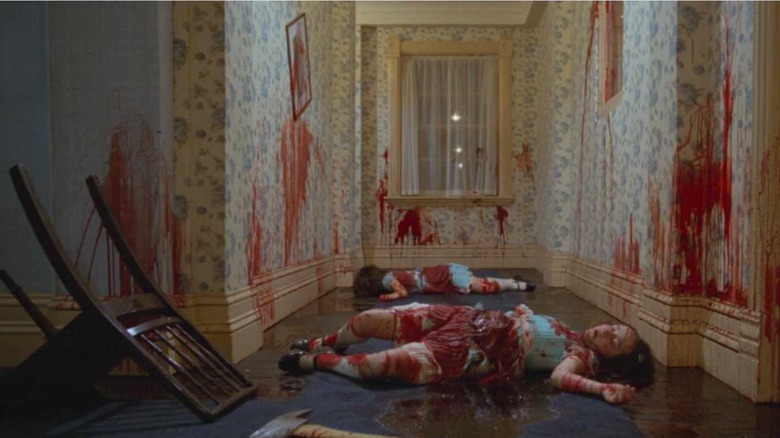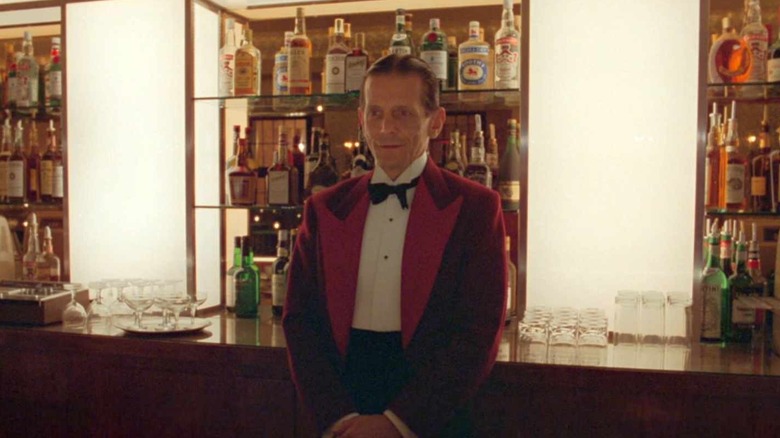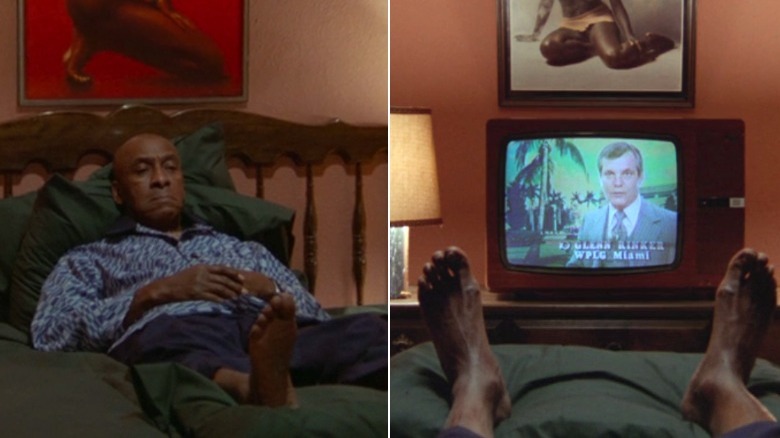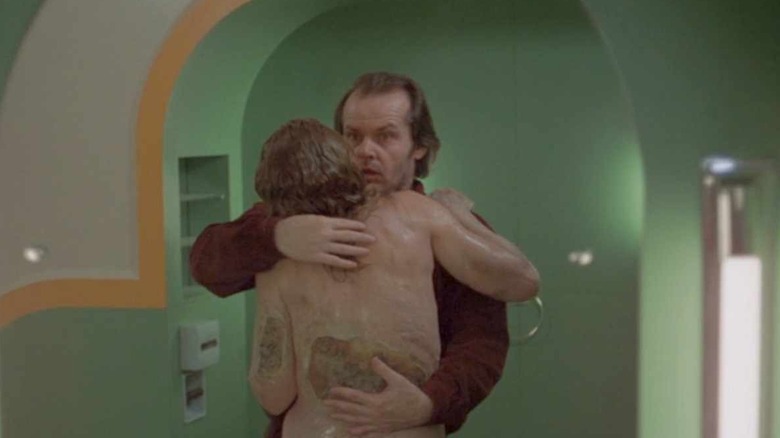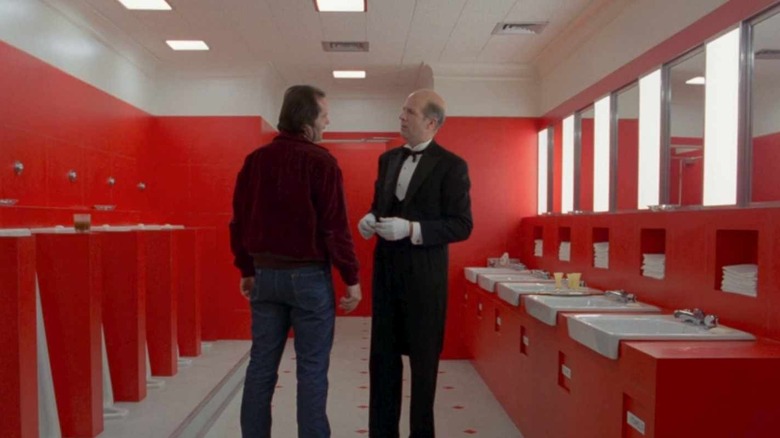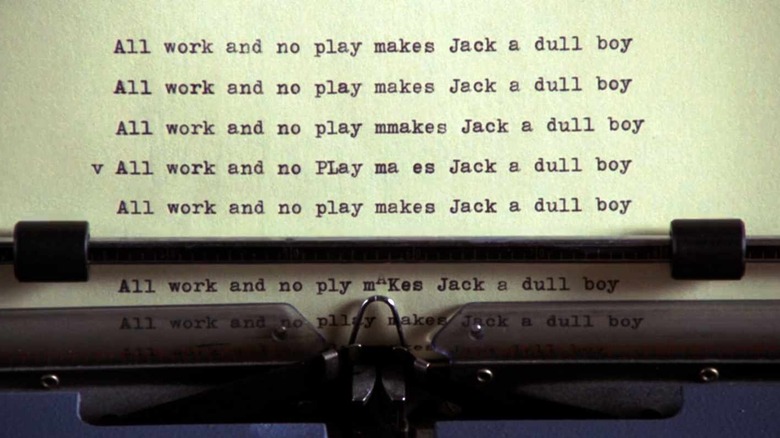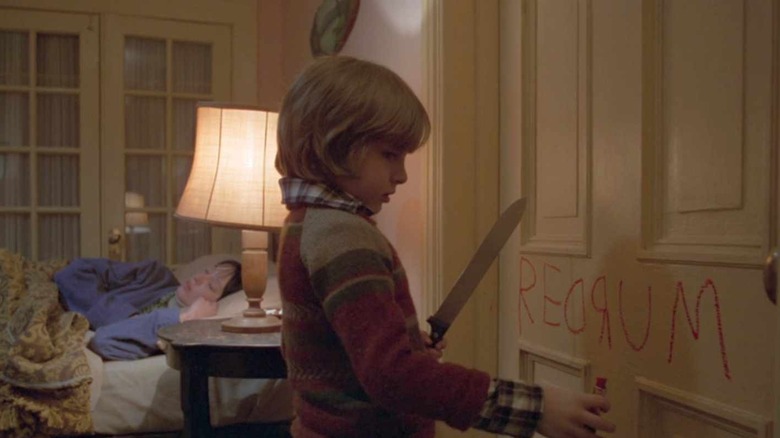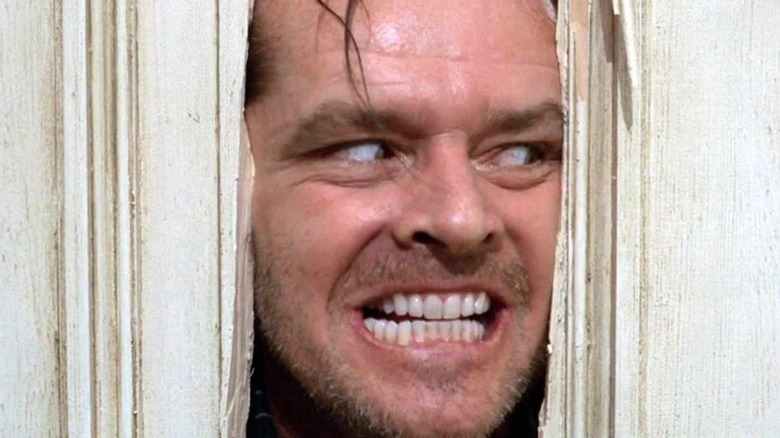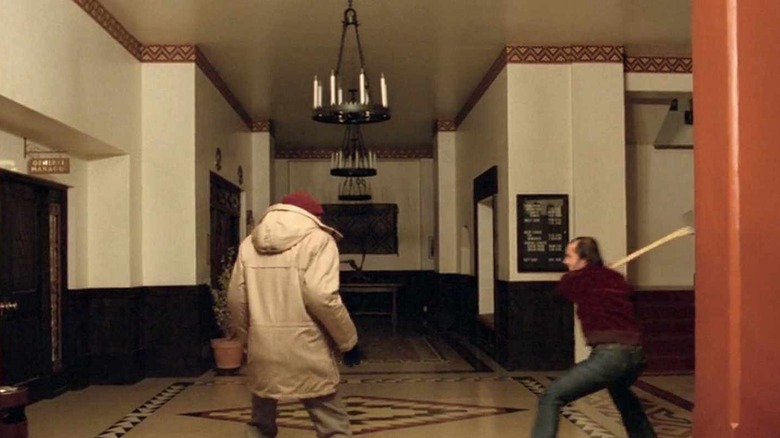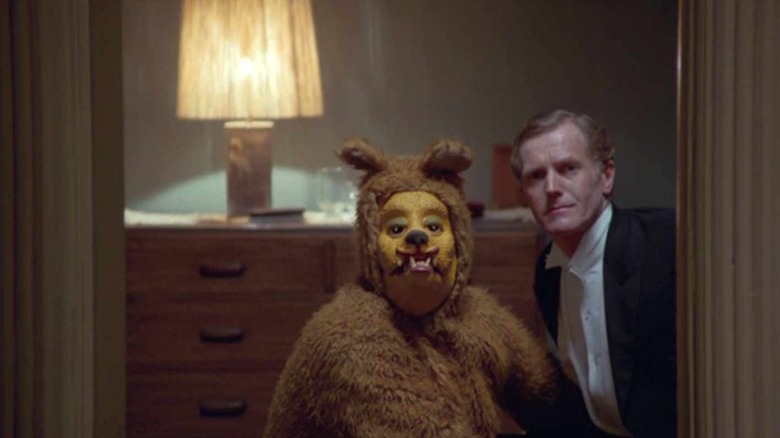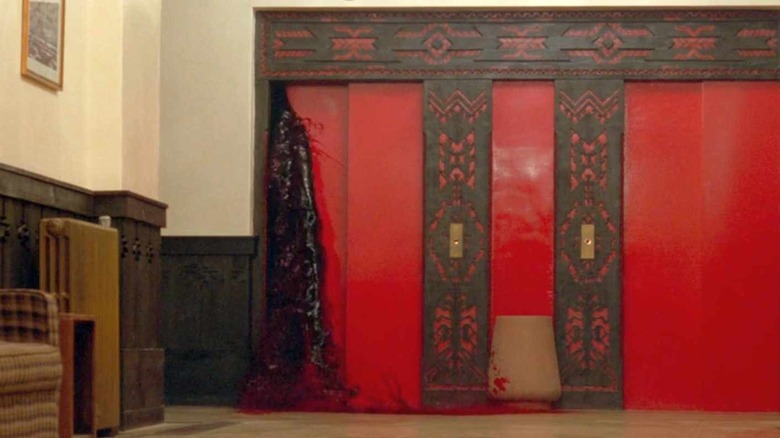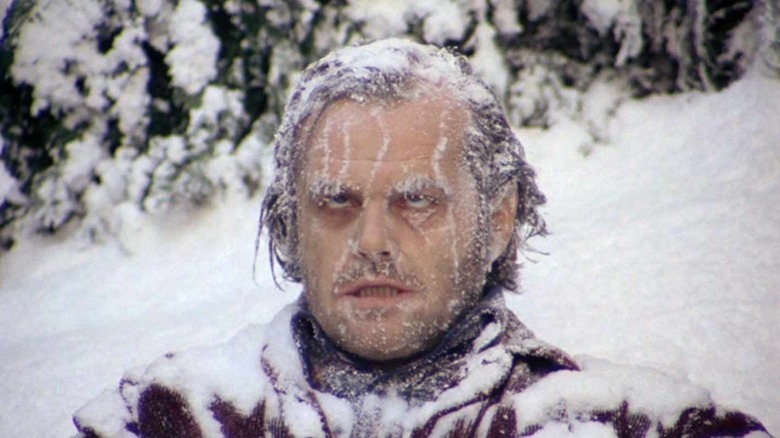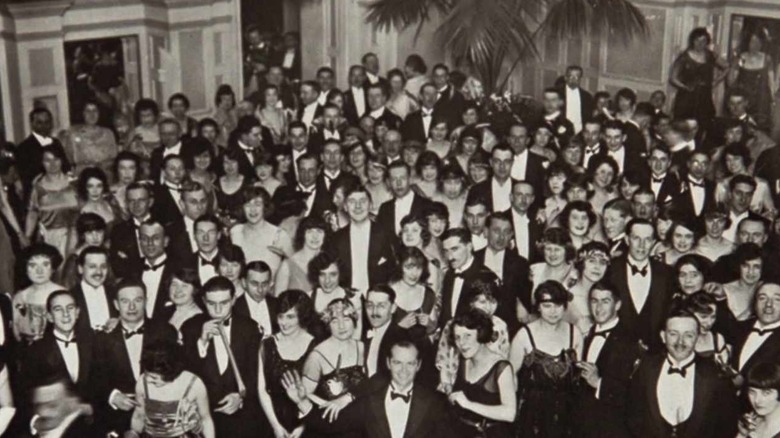The Most Pause-Worthy Moments In The Shining
As a director who rarely repeated himself, Stanley Kubrick's follow-up to his 1975 period piece "Barry Lyndon" had him venturing into the horrific, tackling Stephen King's acclaimed 1977 novel "The Shining." Kubrick called King's work "ingenious and exciting," and added in an interview with Michel Ciment that it struck an "extraordinary balance between the psychological and the supernatural in such a way as to lead you to think that the supernatural would eventually be explained by the psychological."
Kubrick's moody, methodical take on King's story about would-be writer Jack Torrance (Jack Nicholson) shacking up for the winter in isolation with his wife Wendy (Shelley Duvall) and physic-able son Danny (Danny Lloyd), at a remote mountainous resort with a deadly dark past, went head to head with "The Empire Strikes Back" at the box office. While it wasn't exactly a financial success, was nominated for a Razzie (since rescinded) and King himself wasn't a fan ("it's like a big, beautiful Cadillac with no engine inside it"), four decades have passed and "The Shining" is still penetrating and haunting cinephiles' psyches.
There is so much to take in and then unpack in 146 minutes of Kubrick's subtle terror-a-thon that a single viewing of "The Shining" is simply not enough; perhaps, not even 10 viewings are. Some fans have seen it so many times that they see things no one sees, and theorize beyond the Overlook's grounds (as depicted in Rodney Ascher's engrossing documentary "Room 237").
There are many iconic "Shining" moments, some so mindblowing that they require pause, and additional time to digest. With that in mind, here are the best pause-worthy moments in Kubrick's "The Shining."
The Mirror Has Two Faces... and Two Fingers
Kubrick told Michel Ciment that "Danny has had a frightening and disturbing childhood. Brutalized by his father and haunted by his paranormal visions, he has had to find some psychological mechanism within himself to manage these powerful and dangerous forces. To do this, he creates his imaginary friend, Tony, through whom Danny can rationalize his visions and survive."
We first meet Tony when Jack is at his interview at the Overlook, and tells Danny that he got the job. Tony, who Danny calls "the little boy who lives inside my mouth" speaks to him via his index finger (which, contrary to popular belief, was NOT improvised by actor Danny Lloyd). Tony tells Danny that he doesn't want to go to the Overlook hotel. Danny presses him to fess up as to why, and instead of telling him, he shows him future pause-worthy scenes from the movie — imagery of blood flowing out of the elevator banks, the creepy twin girls in the hallway, and even a vision of Danny silently screaming in the future.
Right before the imagery is shown, Danny freezes up in front of the mirror, revealing there are more cracks to come. His knowing and scared look is not only a shock to him (and causes him to black out), but discomforting to the audiences as well. It's also one of the first of many paused looks by our characters, essentially staring into (an unsafe) space.
No Work and All Playgirl...
On closing day, the Torrances arrive at the Overlook, with operations shutting down for the long winter. While Wendy and Danny settle in, Jack is set to meet with his boss, Stuart Altman (Barry Nelson) and his assistant Bill Watson (Barry Dennen), and waits for them in the hotel lobby. As the two leave Jack waiting, it allows him to grab a bite to eat, and catch up on the latest issue of "Playgirl." Wait, what? Jack Torrance is about to start a new job, and before meeting with his employers for just the second time, he's going to be caught with a "Playgirl" magazine in hand?
There are too many questions to ask here, but the main ones are, how did the magazine get there — was it already in the lobby, or did Jack bring it with him from home? Why was he reading it? And did he read any interesting articles? Sure, people in the past occupied themselves while waiting with physical media instead of playing on their phones, but this head-scratching moment is worth closer inspection.
Less than a year after the film's release, Jack Nicholson himself would grace the cover of the April 1981 issue of "Playgirl."
A-Maze-ing
The Torrances seem to be enjoying their home for the winter, and are comfortable exploring their surroundings. While Jack is "trying" to drum up ideas for his "writing project," Wendy and Danny attempt to navigate the Overlook's large hedge maze. When Wendy and Danny make their way into the middle of the maze, Jack is in the hotel lobby and spots a miniature model. He stops to look at it and a-maze-ingly sees his wife and child within the miniature. The viewer sees them as tiny specks in an overhead shot of the maze; this is often the case in the Overlook, where it's hard to "overlook" the weird things that appear before one's eyes.
While Wendy and Danny take delight in the beauty of the maze's greenery, when she says "I didn't think it was going to be this big," the audience knows they're not exactly having the time of their lives. Mazes always sound like a good idea at first, but usually aren't all that fun to do, and "The Shining" has made people second guess trying to navigate them ever since. Even the crew of the film, according to steadicam inventor and operator Garrett Brown, "got lost at various times [on the maze set] and it wasn't much use to call out 'Stanley' as his laughter seemed to come from everywhere!"
Icy Cold Stare
A snowstorm ("one of the worst we've had for years," says a forest ranger) has enveloped the Overlook, mostly confining the Torrances to its interiors, with each family member carrying on about their own business, although Wendy and Danny can't resist a frolic in the snow (which was made of formaldehyde and salt).
Jack has been slowly isolating himself from his family as he furiously types away on his manuscript, taking a break in his work periodically to look out the window and see them enjoying themselves. The white of snow casts a ghostly spotlight upon Jack, as the camera zooms in on his stone-faced peering gaze. With Nicholson's signature eyebrows beyond full arch, his pupils almost bordering his eyelids, and the smallest tinge of a smile peaking out, the scale of the movie is about to tip from safety to danger. Without doing anything besides looking, Nicholson delivers perhaps the most menacing stare he's ever delivered on screen, which is saying something, since Nicholson is the king of menacing cinematic looks.
Hallway to Hell
While Danny has seen flashes and brief appearances by the creepy twin girls in matching blue dresses before, it all comes to a head after his latest Big Wheel trek around the hotel. After driving past the employee-only areas of the hotel, and then back onto the accommodations area, he makes a sharp left turn and is stopped dead in his tracks at the sight of the hand-holding twins at the end of the hall. He breathes heavily, and the audience does too, and the girls begin to speak for the first time, in unison, asking Danny by name to "come and play with us... forever and ever and ever."
Taking a pause to look deeper at Danny's vision — a hallway which was pristine a second ago and is now soaked in blood — you can see the two girls' dead bodies lying behind an axe before them, and a not so self-explanatory chair face down on the floor. Danny cannot hide from his visions, but tries to cover his eyes from the horror, and when he finally pulls back his fingers to take another look, the hall has returned to normal.
As for the bike used for filming? Danny Lloyd was promised it would be sent to him after "The Shining" wrapped, telling The Guardian in 2017, "I was waiting and waiting for it, but it never came."
Hi, Lloyd
Jack awakens from a horrible nightmare in which he murdered his wife and child and cut them into little pieces. Wendy rushes to his side to calm him down, as Danny arrives with his Apollo 11 sweater torn, and his neck bruised. Wendy turns from comforting to confrontational, accusing the previously-abusive Jack of doing this. Jack is starting to lose it, but he needs to cut loose and so he enters the empty Gold Room, pulls a seat up at the zero-stocked bar.
As Jack furiously rubs his eyes in desperation, and then opens them, his frown is instantly turned upside down as a ghostly barkeep now stands before him. Jack greets him with a laugh and "Hi, Lloyd. A little slow tonight, isn't it?" In a jarring cut, there is Lloyd (Joe Turkel, in his third Kubrick film, and opposite an actor that he was "responsible for his career"), standing before bar shelves stocked with liquor. Jack changes his mind on how to end his 5 months on the wagon, from beer to bourbon on the rocks, and Lloyd is happy to oblige. Jack is once again knocked back into reality, as Wendy arrives with news about Room 237; while Jack appears inebriated, the bar is once again empty, and Lloyd nowhere in sight.
For Kubrick, he said the scene was very difficult to do "because the emotional flow is so mercurial. It demands knife-edged changes of direction and a tremendous concentration to keep things sharp and economical. In this particular scene, Jack produced his best takes near the highest number." (via "Jack's Life: A Biography of Jack Nicholson")
Tasteful Decorations
While relaxing in bed in Miami in the offseason, head chef Dick Hallorann (Scatman Crothers) is far from the Overlook Hotel, but keeping his mind mentally close at hand, knowing the evils that lurk there. He is shaken from his chill state when Danny "shines" to him an S.O.S. of the trouble that is brewing. The paralyzed look on his face alone is pause-worthy, but more so is the "tasteful" art that hangs in Hallorann's bedroom, both above his TV, and his bed frame.
Kubrick was no shrinking violet when it came to sexuality in his films — from the characters on screen, to sets often decorated with erotic art (see "A Clockwork Orange"). Hallorann's two pieces of art are both stark, and stark naked, and briefly take our minds off the worries at hand. A long-running mystery has been the origin of the art, and to this day, only one of the two have been identified.
The one above Hallorann's TV, featuring a woman with both a large necklace and Afro, is a poster featuring model Azizi Johari titled "Supernatural Dream." According to Empire, Johari doesn't even own a copy of the out of print poster and had "NO clue I was even in the movie. I don't do horror." She later was introduced to Nicholson via their Kubrick connection, and said "it was funny to see the look of surprise, shock, on both our faces!"
Bathtub Grin in Room 237
What lies behind room 237 is the film's ultimate ghost, haunting the viewer ever since Danny asks Hallorann about it when they first meet, and him telling the boy that he has "no business going in there anyway — so stay out." Curiosity gets the best of Danny and after he being lured to room 237 and eerily injured, his dad finally decides to take action, and take a look for himself.
As he slowly creeps inside the inexplicably open hotel room, his potential fear is turned to delight when he discovers a beautiful naked woman behind the shower curtain. She embraces him (with model Lia Beldam telling Media Mikes that she "didn't mind the many takes though since I was enjoying kissing Jack Nicholson"), but what starts out as so sultry, turns sour when the beautiful woman transforms into the slimy, rotting corpse of an old woman. He pulls back in disgusted horror, as she loudly cackles and slowly chases him from room 237. Jack is so embarrassed that he lies to Wendy, telling her he found "absolutely nothing" in the room.
In Stephen King's book, the room number was 217, based off of the one he stayed at Colorado's Stanley Hotel (and were the only guests staying there that night), where he was inspired to write "The Shining." Exterior shots of Oregon's Timberline Lodge were used for the film (the interiors and faux exteriors were created at Elstree Studios), and Kubrick told Michel Ciment, "the hotel management asked me to change the room number because they were afraid their guests might not want to stay in room 217 after seeing the film." It was changed to the nonexistent 237, although according to the Lodge, "Room 217 is requested more often than any other room at Timberline."
Potty Talk
To blow off more steam, Jack returns to the Gold Room to grab a drink from his trusty new bartender BFF Lloyd, but this time the ballroom is filled completely with patrons, dressed to the nines. After getting up from the bar to revel in the "fish and goose soirée", he runs into a waiter carrying drinks who spills them onto Jack. The waiter insists they move to the gentleman's room to clean it up. It's all a ploy, as the waiter turns out to be notorious caretaker Delbert Grady, who murdered his twin girls, wife, and then himself, and he's making his presence here to let Jack know that he needs to "correct" his family, like Grady did with his.
This bathroom verbal showdown (with seriously long, and longly serious stares) is where Jack learns his true mission at the Overlook. It also sets up the final act of the film, where there is no turning back from this point forward. There is also no forgetting this scene. The vibrant red walls and soft white lights only add to the memories of it. Kubrick told Michel Ciment that his bathroom "was inspired by a Frank Lloyd Wright men's room in an hotel in Arizona." The "Shining" loo in turn inspired writer/producer Bryan Fuller, who told EW that he's "been wanting to do the bathroom [set] forever," and finally got to in his show "Hannibal," and even one particular pit stop at SFMOMA.
All Work And No Play Makes Jack A Dull Boy
Wendy is at wits end about what to do. She wants to get Danny out of the Outlook, but knows Jack won't leave since he risks being a failure at something once again if he does.
Wendy wants to talk it over one more time with Jack, but this time, while she will still speak softly, she will be carrying a big stick — a bat, just in case. When she enters the Colorado Lounge, where Jack has been working on his manuscript, he's not there, and she finally takes a peek at what he's written. It is page after page of nothing but "All Work And No Play Makes Jack A Dull Boy."
The proverb, which dates back to at least 1659, is typed out in various formats: single-spaced, double-spaced, paragraph form, script form, and even triangle shaped. After Jack comes from behind and surprises Wendy reviewing the "work," he asks "how do you like it?"
Kubrick, ever the perfectionist, had 500 or so "dull boy" pages typed up by his secretary Margaret Warrington. He also had her type up similar idioms out in other languages, for use in international releases. The typed pages currently reside in the Stanley Kubrick Archives, at the University of Arts in London.
REᗡЯUM
"The Shining" excels as a different kind of horror movie because its pace is a bit slower, more deliberate than the usual slasher films of the day. But the pace quickens in the final half hour, as Jack is about to be set loose (by the ghost of Grady?) after being locked up in the kitchen pantry, Hallorann is making his way to the Overlook in a terrible storm, and Wendy is taking a well-deserved rest. Then there's Danny, who is not doing so well.
Casually walking around with a large knife in hand, Danny keeps repeating "redrum," with its own quickening pace that makes the audience's heart beat at an uncomfortable rate. With a knife in one hand, Danny now has lipstick in the other and scrawls "redrum" in the door. But what does it mean? Danny is now so loud with his "redrum" chants that Wendy jumps out of bed, attempts to make him snap out of it, but stops in her tracks when she sees "redrum" in reverse in a mirror.
Pause quickly, because a moment later, the crack of an axe is heard on an exterior door.
Here's Johnny!
Jack is back, and he is not happy. With axe in hand (and to grind), he's on a mission to make his earlier nightmare a reality, and nothing will stop him from murdering his family. Wendy and Danny retreat to their apartment bathroom, and Danny is able to slip through the tiny window to escape outside. Wendy is forced to listen to Jack's poorly-timed comedy routine while chopping down the door; he saves his best line for last: "Here's Johnny!"
"That was my idea," Nicholson told the AP in 1980. "Stanley has been living in England for years and isn't familiar with the 'Johnny Carson Show.' He agreed that was the kind of thing the guy would do."
The original line was Carson's sidekick Ed McMahon's signature introduction of the host, and in his aptly named memoir, "Here's Johnny!," said he must have uttered it "almost five thousands times. When he first "richly rolled the R," harking back to his radio days, "the gods must have been smiling at" him as he created "one of the most memorable phrases in television history." Nicholson turned the phrase on its head forever (and ever), delivering the line of the movie, and one of the most iconic in all of film history.
The image of Nicholson devilishly peering through the bathroom door is also one of the most unforgettable in film history. It all happens so fast, but just a single still encapsulates the film so effectively that it was used for international release film posters (in lieu of the Saul Bass one).
No Questions Axed
Poor Dick Hallorann. For the last hour of "The Shining," he is completely consumed with the health and safety of an innocent mother and child in distress, and tries his best to rush to their aid. A flight from Miami to Denver's airport, followed by a five hour drive gets him to Durkin's Garage, where he picks up a Snowcat to ascend the rough roads of the mountain leading to the Overlook. Hallorann presents hope for Wendy and Danny (and the audience too) that perhaps good can triumph over evil. If only things that were that simple.
No sooner does Hallorann enter the Overlook than he meets the wrong end of the stick. Jack pops out of nowhere and instead of asking questions, axes him straight to the heart. The scene is so startling that actor Dan Lloyd recalled to The Guardian that to protect his well being, he "was banned from the set for the entire time Scatman Crothers was being axed," and wasn't even aware he was starring in a horror film.
According to Kubrick assistant Emilio D'Alessandro, two axes were used in the scene: a real one, and "a light fake one full of blood-like liquid that would spray all over the place on impact with Halloran's chest. Nicholson had practiced how to use the fake axe, so that you couldn't see the difference in weight from the way he moved."
One axe from the film recently sold for $175,000, and will be housed at the same Stanley Hotel that inspired King.
That one Shining Moment
Out of all the crazed moments within "The Shining,” there is none like the one where a guy in a bear costume is "visiting" with a man in a tuxedo. When Wendy is running up the stairs, knife in hand, she interrupts these two; their awkward appearance lasts only 13 (pause-worthy) seconds, but creates a lifetime of nightmares, and questions that today remain unanswered.
Nothing about this scene is ever explained in the Kubrick film, deepening the mystery. So is the fact that the two actors who played in it were never credited, and for a long time, even identified. It was later revealed that Brian V. Towns played the formal man, and in a 2019 interview said that the "rather rude" scene opposite Eddie O'Dea in the bear costume was "just another job," and when his work on the film wrapped after a few weeks, he "forgot all about it."
Towns himself later became curious about the mysterious scene he took part in and wanted to "discover how it fits into the film." Like many, it led him back to the King source material, where it details an incident of a previous owner of the Overlook, Horace Derwent, and how he humiliated his lover, Roger, by making him dress up in a dog costume and act like an obedient canine in front of guests at the ballroom.
Elevated Bloodwork
Danny had warned the audience for quite a while of the deluge to come. Not even 12 minutes into the film, through his shined visions, glimpses of the twin elevator bloodletting preview the horror to come for him and his family.
Deep into the final act of the film, when the Overlook has fully let its hair down, it begins to make sense. After unleashing and exposing all of its bad juju, mainly for only Wendy to see, the Overlook literally erupts when blood pours down from the elevators and floods the ground floor in a sea of red.
This bloody moment has forever been etched into popular culture, and was so visually stunning it was used in its entirety for the original teaser trailer. Kubrick was so worried about pulling it off that assistant Leon Vitali revealed to Yahoo! that "Stanley couldn't bring himself to watch it. When we were all on set, Stanley said, 'Keep an eye on it and tell me if anything goes wrong.' And then he walked out.'"
It's such an iconic moment that it has been referenced and recycled into other moments within popular culture. During a "Treehouse of Horror V" "Shining" homage on "The Simpsons," Mr. Burns' elevators bleed and he replies "hmm, that's odd, usually the blood gets off on the second floor." The bloody elevators got an extended flow in Steven Spielberg's 2018 film version of "Ready Player One." Spielberg first met Kubrick on the set of "The Shining," and he got to pay tribute to him with four-and-a-half minutes of Overlook reverence in a key sequence. While most of it was done with CGI, Spielberg admitted to EW that they "built the elevators and we built the hallway leading up to the elevators" (via /Film). The 2003 film "Fear X" references it with its own bloody elevator homage (at 1:15:34), and the bloodwork is so iconic that the "Doctor Sleep" sequel filmmakers didn't bother to recreate it and just reused the original footage.
Frozen in Time
The good guys (Wendy and Danny) escaped, and are free of the evil clutches of the Overlook and its caretaker. When we last saw Jack, he was chasing Danny around the dark and snowy hedge maze. Injured, lost, and exhausted, Jack plops down. Night cuts to day, and Kubrick leaves us on a medium shot of Jack, literally frozen in time (in direct contrast to King's "fiery" ending).
What will become of Jack? Did he freeze to death? Probably. His still-life look resembles a painting that no one would want hanging in their home, but it's a lasting image to (almost) end the movie with. From these rare behind the scenes photos, you can see how difficult it was to prop up Nicholson and make him look frozen over.
Nicholson told the St. Louis Dispatch that Kubrick was "relentless," adding "he shot almost everything in 'The Shining' head on, from directly in front, with full focus on each actor and an awful lot of tight closeups. It doesn't allow for many mistakes, and it puts a lot of pressure on you as an actor "
You Have Always Been The Caretaker
A split second after the "freeze" frame of Jack entrenched in snow, with nowhere to go, Kubrick brings the viewer back into the confines of the Overlook for one last reveal.
The camera is situated right outside of the entrance of the Gold Ballroom, and slowly tracks forward towards a wall of 21 photos. It further focuses on a picture in the dead center, a group photo of a grand ball. Front and center of the group is a familiar face: Jack Torrance. The camera cuts closer and closer, then pans down to reveal further details: Overlook Hotel, July 4th Ball, 1921. Kubrick originally wanted to stage that photo with extras, but it "proved impossible" and decided to work with an existing photo from 1921 he found in an archive, airbrushing Nicholson's face into it.
So Delbert Grady was right, it seems to many, and Jack has always been the caretaker. If you ever wondered what Kubrick wanted you to think, he relayed to Ciment, "I hope the audience has had a good fright, has believed the film while they were watching it, and retains some sense of it. The ballroom photograph at the very end suggests the reincarnation of Jack."
